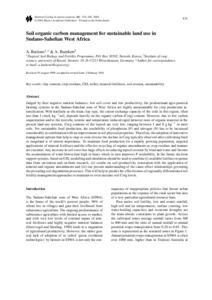| dc.date.accessioned | 2007-04-25T11:08:33Z | |
| dc.date.available | 2007-04-25T11:08:33Z | |
| dc.date.issued | 2001 | |
| dc.identifier.issn | 1573-0867 | |
| dc.identifier.issn | 1385-1314 | |
| dc.identifier.uri | urn:nbn:de:hebis:34-2007042517821 | |
| dc.identifier.uri | http://hdl.handle.net/123456789/2007042517821 | |
| dc.format.extent | 668151 bytes | |
| dc.format.mimetype | application/pdf | |
| dc.language.iso | eng | |
| dc.rights | Urheberrechtlich geschützt | |
| dc.rights.uri | https://rightsstatements.org/page/InC/1.0/ | |
| dc.subject | clay content | eng |
| dc.subject | crop residues | eng |
| dc.subject | GIS | eng |
| dc.subject | millet | eng |
| dc.subject | mineral fertilisers | eng |
| dc.subject | soil erosion | eng |
| dc.subject | sustainability | eng |
| dc.subject.ddc | 630 | |
| dc.title | Soil organic carbon management for sustainable land use in Sudano-Sahelian West Africa | eng |
| dc.type | Aufsatz | |
| dcterms.abstract | Judged by their negative nutrient balances, low soil cover and low productivity, the predominant agro-pastoral farming systems in the Sudano-Sahelian zone of West Africa are highly unsustainable for crop production intensification. With kaolinite as the main clay type, the cation exchange capacity of the soils in this region, often less than 1 cmol_c kg^-1 soil, depends heavily on the organic carbon (Corg) content. However, due to low carbon sequestration and to the microbe, termite and temperature-induced rapid turnover rates of organic material in the present land-use systems, Corg contents of the topsoil are very low, ranging between 1 and 8 g kg^-1 in most soils. For sustainable food production, the availability of phosphorus (P) and nitrogen (N) has to be increased considerably in combination with an improvement in soil physical properties. Therefore, the adoption of innovative management options that help to stop or even reverse the decline in Corg typically observed after cultivating bush or rangeland is of utmost importance. To maintain food production for a rapidly growing population, targeted applications of mineral fertilisers and the effective recycling of organic amendments as crop residues and manure are essential. Any increase in soil cover has large effects in reducing topsoil erosion by wind and water and favours the accumulation of wind-blown dust high in bases which in turn improves P availability. In the future decision support systems, based on GIS, modelling and simulation should be used to combine (i) available fertiliser response data from on-station and on-farm research, (ii) results on soil productivity restoration with the application of mineral and organic amendments and (iii) our present understanding of the cause-effect relationships governing the prevailing soil degradation processes. This will help to predict the effectiveness of regionally differentiated soil fertility management approaches to maintain or even increase soil Corg levels. | eng |
| dcterms.accessRights | open access | |
| dcterms.bibliographicCitation | In: Nutrient Cycling in Agroecosystems. Dordrecht : Kluwer. 61.2001, S. 131-142 | |
| dcterms.creator | Bationo, André | |
| dcterms.creator | Bürkert, Andreas | |
| dc.description.everything | The original publication is available at www.springerlink.com | eng |

